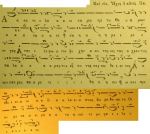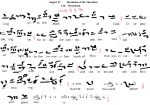Just curious if he can follow up as to why this takes priority over formulaic integrity as advocated by Papa Ephraim?
My position concerning FATHER Ephraim's COMPOSITIONS (I do NOT call them ADAPTATIONS) has been clear ever since the beginning.
My method considers that NO ONE today is of the caliber of such ADAPTATIONISTS as, for instance, Macarie Ieromohahul, Anton Pann (Ἀντωνιος Παν[τολέων] according to Giannopoulos) who were FORMED in the Greek musical system, and who knew ALL of its (Greek) as well their own (Rumanian) tradition BY heart.
Their adaptations follow the AXIOMS I have presented.
The reason is VERY simple to understand.
Each FEAST has its own "akousma" or "SOUNDING". This is easibly verifiable in the Katavasiai. Any Greek listening to a CREDIBLE adaptation in Rumanina can GUESS if one is dealing with either a Nativity of Christ or a Dormition of the Theotokos Katavasia.
The same goes for the rest of the the hymnology: there must be EASY RECOGNITION of the chanted hymn for the simple reason that the COMBINATION of PALEOGRAPHIC formulae for a given hymn don't just "come out of the blue"..... They have been set on paper by "GREAT ONES" back then.
Given that there are NO Makarie Ieromonahuls or Anton Panns in OUR days, my method requires that a FULL database be created BEFORE attempting ANY adaptation whatsoever.
Fr Ephraim feels that his dictionary is "statistically" sound, and that it covers well MOST of the Greek repertoire written out in Contemporary Psaltiki Notation (CPN).
MY view is that his dictionary is NOT "statistically" sound ENOUGH, in that
== it LACKS the ODD/very RARE cases seen in some CLASSICAL editions,
== it LACKS formular CORRESPONDANCE between paleographic psaltic notation (PPN) and Contemporary Psaltiki Notation (CPN): this is CAPITAL in understanding how a SAME metrophonia can have DIFFERENT RHYTHMIC EMPHASIS for the SAME tonic AND verbal sequence ("logophonia").
== it LACKS complete use of CPN/Paleographic sources in OTHER languages
== it LACKS any reference to EXISTING O/AURAL renderings in ALL languages, ESPECIALLY Greek, that have yet to be written out.
The creation of such a COMPLETE dictionary is an ACADEMIC issue: it requires many EXPERTS from VARIOUS fields.
I therefore started out by participating in a project that created a FREE OCR for CPN but that can also be used for PPN.
I've asked the editors of Melodos (Savvas Papadopoulos) and other programmers/researchers (including Giannoukakis) that they all take into consideration the existence of TONIC sequences, and that they slowly intergrate/use this notion in SEARCH engines (that will allow x%HOMOLOGY searches, like with DNA databases, as opposed to 100%HOMOLOGY searches in Word).
BZQ by my compatriot Panayiotis Katsoulis can easily integrate such modules (for those who will not buy Melodos), and provide scores when used in conjunction with MK (by Dimitrios Papadopoulos).
All this shows that in spite of some KNOWLEDGE I may have on psaltiki [I've been CHANTING for OVER forty (40) years)], I feel that there is a METHODOLOGY that needs to by applied, and which goes BEYOND that proposed by FATHER Ephraim.
As such, I understand the immediate NEED for some functional psaltic scores. The results provided by Fr EPHRAIM and other "COMPOSERS" in this forum are NOT to my liking for the reasons stated above.
In a few words, I DO NOT accept METROPHONIC DEFIGUREMENT for the sake of some FORMULAR "respect" based on an INCOMPLETE formular dictionnary (in spite of how "statistically "sound" Fr Ephraim might wish to consider it).
I have therefore set out to ADAPT a number of hymns myself (namely a NEW anastasimatarion in English based on HTM), according to the AXIOMS I have stated, which I feel REPRESENT the TRADITIONAL ORTHODOX way of "thinking" and ACTING.
This is in LINE with other GREEK origin psaltes such a Archon Constantinos Lagouros (adaptations in French) and Nikolaos Chantzinikolaou (adaptations in English) who take a GREEK original and try their best to "stick to it" according to the aformentioned axioms.
Since we're all "still alive", English COMPOSERS can still ask us our opinion.
That way, some TEMPORARY compositions can be made, while waiting for a COMPLETE database to be created.
And even THEN, the GREEK origin adaptationists will STILL HAVE TO BE an unavoidable source of information.
On some of hymns, when there are two Greek classical versions to compare, they don't even follow these rules.
There are a number of possibilities
=== either we have one ONE original paleographic score, and composer 1 does a MORE homogeneous adaptation as opposed to composer 2 == composer 1 is therefore ADAPTING while composer 2 is COMPOSING or IMPROVISING
=== either there are a NUMBER of Paleographic scores or O/AURAL tradition renderings of the SAME hymn BACK then, and each composer is BLENDING EXISTING formulae for that PARTICULAR hymn = this is an ADAPTATION of "mixed" origin (based on a NUMBER of prototypes, instead of just one)
=== or either of BOTH composers 1 and 2 are IMPROVISING.
The classical example of MULTIPLE METROPHONIA variations is presented in the Holy Friday Antiphononon 1 Archontes laon (see my 2009 presentation): the multiple variations in Contemporary Psaltic notation are BASED upon DIFFERENT PALEOGRAPHIC scores of the same hymn. By consequence, the existence of different renderings of the same hymn is well vouched for by WRITTEN (paleographic) tradition.
Beyond WRITTEN paleographic tradition in a given language, other RESOURCES include WRITTEN paleographic tradition in OTHER languages AS WELL AS O/AURAL tradion in ALL languages (I mainly refer to Greek, Slavonic and Rumanian).
Example being αίμα και πυρ, and usually there can be several differences between the 1820 δοξαστάριον of Efesios and the corresponding hymns in Mousike Kypseli. A great example to me would be the Vesperal Doxastikon of the Exaltation of the Cross. Both Doxastika have similar phrasing and melodic contours until the phrase τὰ ἐν ξύλῳ λῦσαι πάθη τοῦ κατακρίτου. Here we have Stephanos performing a complex modal phrasing that never rises above the note Δι, eventually resolving on Νη, where Petros has it take a rather common melodic thesis in 2nd mode with it reaching high ζω and resolving on βου, so while both end the phrase by descending, the modal structure and actual "flavor" of the two are extraordinarily different. So if two composers/transcribers only 37 years apart in the Patriarchate itself can differ
See argument concerning metrophonic/rhythmic VARIATIONS ALREADY EXISTING FOR A PARTICULAR HYMN...
why is it so important for the English compositions/adaptations strictly follow the Greek melodic skeleton?
Because before Fr Ephraim et al, others who knew GREEK hymnology BY heart (and I don't just mean the ANASTASIMATARION in its WRITTEN form) and at the time of Petros or of the Three teachers ,decided to do so, that is, ADHERE to some metrophonic/rhythmic homogeneity according to some GREEK prototype....
I guess, it seems to me to make more sense to basically reverse the priorities.
What makes "more sense" to YOU, Samuel, is of NO CONCERN to me.
I'm telling you how tradition has worked THUS far.
If the Rumanians and Slavs have not inverted the priorities, just who do some English speaking composers think they are to "THINK" otherwise?
Follow the Greek skeleton until it doesn't fit the English, and when one deviates make sure it is using a traditional Greek formula.
????
The example I can use in my work was in the
Vesperal Doxastikon of the Transfiguration. The phrase "cast themselves upon the ground, O Word..." I chose to end on low Δι, and set that up with "disciples..." On Νη, even though the Δοξασταριον of Petros, with the text not quite mirroring the English, has Οἱ Μαθηταί σου Λόγε end on Δι and ἔρριψαν ἑαυτοὺς ἐν τῷ ἐδάφει τῆς γῆς descend to Νη then all the way to low Δι. There was no way to match the text where "Word" ends on high Δι and the rest go to low Δι, so thus I made sure that it formulaically was correct, and just ended the whole phrase on low Δι and scratched trying to find a way for "Word" to end on high Δι, especially since the translation has it after "upon the ground" which has to descend to low δι. You can see in my rough draft I tried to accommodate this, but changed it in the final draft because the result was too jarring and linguistically leaves the listener confused as to what is going on. This is an example where I believe it is far more important to stay formulaically sound than to match the Greek melodic structure.
THIS is an example where one should have READ ALL the existing contemporary psaltiki compositions in Rumanian and Slavonic (which I assume you did not do), and while waiting for a COMPLETE database (coming soon in about 5 years), one can always contact guys like GKM and Lagouros and others who were BORN in the tradition and heard MORE than some of you folks, and who might try to find an "improvisation", which later on might ALSO PROVE to EXIST in WRITTEN form in the aforementioned repertoire (I've proven this MANY times to Andrea ATLANTI).
All in all, what I call "Anglophone COMPOSERS" are COMPOSING and NOT adapting, as far as I'm concerned.
They are SYSTEMATICALLY "defiguring" METROPHONIA, by transforming EXCEPTIONS (metrophonia adaptation variations) into RULES, thus making their English Compositions Metrophonically UNRECOGNISEABLE to the rest of the orthodox community.
Tell GKM thanks for taking the time to reply to these threads.
Tell your fellow COMPOSERS to "calm down".... psaltic tradition isn't AS SIMPLE as an INCOMPLETE formular dictionary and ad libitum combination of its content.... I've written you a PERSONAL message to let you know how I REALLY feel about your "work".


